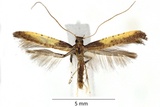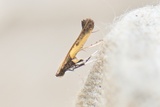Caloptilia azaleella (Brants, 1913) Species
Last modified: Dec. 10, 2025, 1:35 p.m.
A rare species in Belgium, mainly in azalea nurseries and parks with Rhododendron.
Details
- Classification
- Family: Gracillariidae > Subfamily: Gracillariinae > Tribus: Gracillariini > Genus: Caloptilia > Species: Caloptilia azaleella
- Vernacular names
- Azaleasteltmot (NL), Azalea leaf-miner (EN), Azaleen-Miniermotte (DE)
- First mention in Belgium
- Lhomme L. 1946–1963. Catalogue des Lépidoptères de France et de Belgique. Volume II Microlépidoptères. (deuxième partie). — — : 489–1253. On page 1061.
- Status
-
Naturalised
Distribution
Caterpillar
First instars green, later on turning more yellowish.
Mine
Underside, brownish blotch mine. Later on a cone by spinning a leaf tip downwards. The cone colours from green to reddish brown.
See also gracillariidae.net and bladmineerders.be.
Cocoon/pupa
A whitish, transparant cocoon.
Bionomics
The young larvae make a gallery in the lower epidermis of a leaf of Rhododendron simsii, R. indicum, etc. This gallery leads to a blotch contorting the leaf. Later, the larva constructs a cone by rolling a leaf downwards from the tip.
Pupation on the underside of the leaf, where the larva first spins a whitish, transparent cocoon which is actually just a membrane. The pupa hibernates and after the emergence of the adult, the exuvium protrudes from the mine. The adults come to light.
Flight periods
The adults fly in two generations a year, in May and July–August. In mild seasons, there is a small third generation during September–October.
Observed on
- Host plant (species):
- Rhododendron indicum, Rhododendron decandrum and Rhododendron dilatatum
- Host plant (genera):
- Rhododendron
Oligophagous on Rhododenron.




